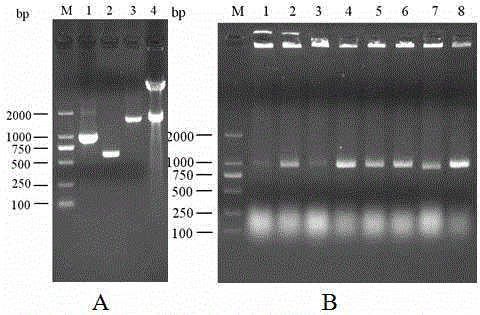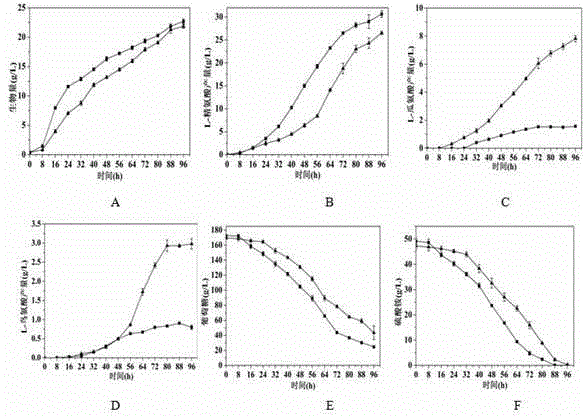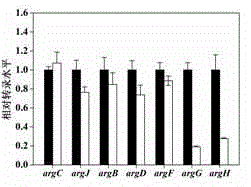Metabolic transformation method for efficiently improving production capacity of corynebacterium crenatum SYPA5-5 L-arginine
A Corynebacterium bacilli, metabolic modification technology, applied in the biological field, can solve the problems of low production capacity of L-arginine, long fermentation cycle, etc.
- Summary
- Abstract
- Description
- Claims
- Application Information
AI Technical Summary
Problems solved by technology
Method used
Image
Examples
Embodiment 1
[0045] Example 1. Releasing the Feedback Inhibition of L-Arginine on NAGK in SYPA5-5
[0046] (1) Recombinant plasmid pK18mobsacB- arg B H268N build
[0047] Obtained from NCBI arg BD sequence, design related primers, use SYPA5-5 genome as template, and use arg B-F / H268N-R, H268N-F / arg D-R are primers, respectively amplified to obtain H268N-5' / H268N-3' homologous fragments, using homologous fragments as templates, and arg B-F / arg D-R is the primer, amplified to obtain the H268N mutation point arg BD fragment, about 1863 bp. Ligate the mutant fragment into pK18mob sac B plasmid, obtain the recombinant plasmid pK18mob sac B- arg B H268N , the result is as figure 1 (A) shown.
[0048] (2) Construction of anti-feedback inhibition strain H-7
[0049] pK18mob sac B- arg B H268N The recombinant plasmid was transformed into SYPA5-5 by electrotransformation. After two times of homologous recombination, 12 transformants were selected for the second reco...
Embodiment 2
[0050] Example 2. Research on the fermentation characteristics of recombinant strain H-7
[0051] Shake flask fermentation was carried out on the starting strain SYPH5-8 and the recombinant strain H-7, and samples were taken every 8 h. The results were as follows: figure 2 shown. Depend on figure 2 (A) It can be seen that the biomass of the recombinant strain is lower than that of the starting strain throughout the fermentation process. Depend on figure 2 (B) It can be seen that the L-arginine production of the recombinant strain H-7 is 26.5 g / L, which is 13.4% lower than that of the original strain (30.6 g / L). Such as figure 2 As shown in (C, D), the recombinant strain accumulated a large amount of L-citrulline and L-ornithine, and the accumulation of L-citrulline reached 7.82 g / L, which was 4.0 higher than that of the original strain (1.56 g / L). times, the accumulation of L-ornithine reached 2.97 g / L, which was 2.7 times higher than that of the starting strain (0...
Embodiment 3
[0052] Example 3. Transcription analysis of genes related to L-arginine synthesis in recombinant strain H-7
[0053] against the recombinant strain H-7 arg The transcription of each gene in the gene cluster was analyzed, and the results were as follows: image 3 shown. arg There was no significant change in the transcript levels of related genes in the CJBDF transcription unit, but arg The transcript levels of G decreased by 4.3 times, respectively, arg The transcript level of H decreased by 2.6 times. arg G-encoded arginine succinate synthase (ASS) and arg The enzyme activity of H-encoded spermine succinate lyase (ASL) was also decreased. The above results show that the SYPA5-5 genome on arg The precise mutation of the H268N site of the B gene releases the feedback inhibition effect of L-arginine on NAGK, which can lead to arg The transcriptional level of GH decreased, which in turn caused the enzyme activities of ASS and ASL to decrease, which may be the main ...
PUM
 Login to View More
Login to View More Abstract
Description
Claims
Application Information
 Login to View More
Login to View More - R&D
- Intellectual Property
- Life Sciences
- Materials
- Tech Scout
- Unparalleled Data Quality
- Higher Quality Content
- 60% Fewer Hallucinations
Browse by: Latest US Patents, China's latest patents, Technical Efficacy Thesaurus, Application Domain, Technology Topic, Popular Technical Reports.
© 2025 PatSnap. All rights reserved.Legal|Privacy policy|Modern Slavery Act Transparency Statement|Sitemap|About US| Contact US: help@patsnap.com



